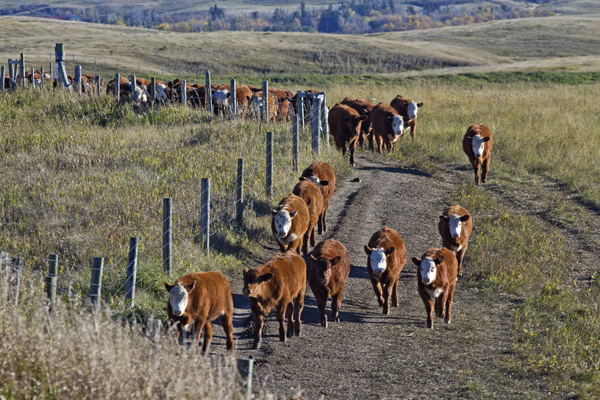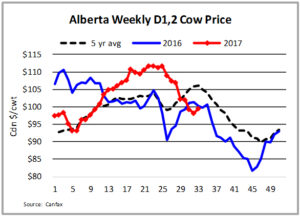Economics of Preg-Checking: a 2017 Update

The major economic benefit of preg-checking is the cost-saving of wintering open cows. However, it has been noted that preg-checking is not always worthwhile, as the increased revenue due to higher prices in the spring and the additional weights put on in the winter could more than offset winter feeding costs.
The economics of preg-checking depends on the cull cow market price, the management system employed by the producer, feed and overhead costs, and veterinary costs. As market dynamics change every year, it is important to consider the current market situation when making preg-checking decisions.
Alberta cow prices experienced an impressive rally in the first half of 2017 but the seasonal decline has been sharp since June. Cow prices are under pressure this summer due to ample fed cattle supplies, dry pasture conditions in Southern Alberta, and Saskatchewan and low exports to the US. On the other hand, the sharp decline in beef imports from Australia could result in stronger demand for domestic lean trim products and support cow prices this fall.
Using the BCRC’s Economics of Pregnancy Testing Beef Cattle Model, the potential economic gain or loss can be estimated for the following three options under different overwintering management systems and price scenarios:
- preg-checking and culling cows in the fall,
- preg-checking and feeding open cows separately or
- not preg-checking and feeding cows over winter.
Basic cow herd information and fall cull cow prices are needed for the calculation. The 2005-2014 cull cow price data used in the model has been updated to the current 10-year (2007-2016) average for the below analysis.
The analysis below assumes a 160-day overwinter feeding period and a 7.7% herd open rate. The assumptions on cost and average daily gain (ADG) for the overwintering systems are shown in Table 1. For the separate feeding scenario, the cost of production is assumed at $1.90/cow/day, ADG of 1.6 lbs, and a 140-day feeding period.
Table 1. Overwintering Systems
| Cost of Production ($/day/head) | Average Daily Gain (lbs) | |
|---|---|---|
| Drylot | $1.78 | 1.44 |
| Swathed Barley | $1.22 | 0.58 |
| Bale Grazing | $0.98 | 0.88 |
| Standing Corn Grazing | $1.78 | 1.17 |
Regarding cow prices this fall, cow supplies typically trend larger moving into fall, and bottom in the fourth quarter. The decline from summer peak to the fall low over the last five-years has averaged 15% and implies cow prices around $95/cwt this fall. Given the big swing in prices this year, the seasonal decline could be steeper. A 20% drop would bring prices to $90/cwt around the five-year average low, and a 25% decline would bring prices closer to the 2016 low of $85/cwt. Over the past five years, the seasonal decline had ranged from 16-33%, with 2014 being the only exception as prices traded counter-seasonally higher in the fall.
Cow prices have increased from November to March in nine out of the past ten years (2007-2016), with the exception being 2015. The percentage increase ranged from 14% to 55% with an average of 27%.
Based on the long-term price seasonality and the above assumptions, the model generally projects economic losses for the ‘preg-check and cull in the fall’ option compared to the ‘no-preg check and cull in spring’ option. For the swathed barley and standing corn grazing winter management scenarios, the model projects economic gains for the ‘preg-check and feed separately’ option compared to the ‘no-preg check and cull in spring’ option.
Table 2. Projected Loss/Gain Compared to No Preg-check and Cull in Spring ($/head)
Cow Price Fall Low | DRYLOT Preg-check, cull in fall | DRYLOT Preg-check, feed separately | SWATHED BARLEY Preg-check, cull in fall | SWATHED BARLEY Preg-check, feed separately | BALE GRAZING Preg-check, cull in fall | BALE GRAZING Preg-check, feed separately | STANDING CORN GRAZING Preg-check, cull in fall | STANDING CORN GRAZING Preg-check, feed separately |
|---|---|---|---|---|---|---|---|---|
| $1.00 | -26.00 | -3.54 | -19.47 | 3.00 | -27.11 | -4.64 | -21.78 | 0.68 |
| $0.95 | -23.83 | -3.51 | -17.96 | 2.36 | -25.37 | -5.05 | -19.82 | 0.50 |
| $0.90 | -21.65 | -3.47 | -16.46 | 1.71 | -23.63 | -5.46 | -17.85 | 0.32 |
| $0.85 | -19.47 | -3.44 | -14.95 | 1.07 | -21.89 | -5.86 | -15.88 | 0.14 |
Higher cull cow prices favour not-preg checking and culling in spring over preg-checking and culling in the fall as every additional pound will be worth more. It should be noted that the projections above are based on a 27% price increase from November to March. If cow prices are flat during this fall to spring 2018, preg-checking and culling early could be worthwhile. Reducing the assumption on November-March price increase to 5%, the preg-checking and culling in the fall option will be worthwhile in most price scenarios for the Drylot, Swath Barley and Standing Corn Grazing winter management systems (Table 3).
Table 3. Projected Loss/Gain of ‘Preg-check and Cull in Fall’ vs. ‘No Preg-check and Cull in Spring’ with Assumption Changed to 5% increase in cow prices from November to March
| Cow Price Fall Low | Drylot ($/head) | Swathed Barley ($/head) | Bale Grazing ($/head) | Standing Corn Grazing ($/head) |
|---|---|---|---|---|
| $1.00 | -0.34 | 3.88 | -2.95 | 3.15 |
| $0.95 | 0.56 | 4.22 | -2.42 | 3.87 |
| $0.90 | 1.45 | 4.55 | -1.89 | 4.59 |
| $0.85 | 2.35 | 4.89 | -1.35 | 5.31 |
The above scenarios show that feeding cull cows separately provides the greatest economic benefit this year for the swathed barley and standing corn grazing management systems. The gains are driven by the higher price in the spring, ADG of the separate feeding group, and the length of the feeding period. Changing these assumptions could result in a different conclusion. For example, if separate feeding period was shortened to 90 days, even with an increased ADG to 1.8 lbs, the separate feeding option is projected to result in economic losses compared to the no preg-check option in all scenarios (Table 4), as the increased revenues from the additional weight gain were not large enough to offset the additional costs.
Table 4. Projected Loss/Gain of Preg-check and Feed Separately vs. No Preg-check and Cull in Spring – Changed Assumption to a 90-day feeding period and 1.8 lbs ADG
| Cow Price Fall Low | Drylot ($/head) | Swathed Barley ($/head) | Bale Grazing ($/head) | Standing Corn Grazing ($/head) |
|---|---|---|---|---|
| $1.00 | -21.23 | -14.70 | -22.34 | -17.01 |
| $0.95 | -19.95 | -14.09 | -21.50 | -15.94 |
| $0.90 | -18.67 | -13.48 | -20.65 | -14.87 |
| $0.85 | -17.39 | -12.88 | -19.81 | -13.80 |
The BCRC’s Advanced Economics of Pregnancy Testing Beef Cattle Model provides the flexibility of entering your own overwintering costs, ADG, length of winter feeding period and other variables. We encourage you to try the calculator and adjust assumptions based on your own records.
This blog post was prepared by Canfax Research Services with support from the Knowledge Dissemination and Technology Transfer project funded by the Canadian Beef Cattle Check-off and Canada’s Beef Science Cluster.
Click here to subscribe to the BCRC Blog and receive email notifications when new content is posted.
The sharing or reprinting of BCRC Blog articles is welcome and encouraged. Please provide acknowledgement to the Beef Cattle Research Council, list the website address, www.BeefResearch.ca, and let us know you chose to share the article by emailing us at [email protected].
We welcome your questions, comments and suggestions. Contact us directly or generate public discussion by posting your thoughts below.
